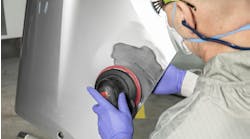Guest Blog: The Future of Collision Repair Estimation: Precision, Adaptability, and Shop Success
As vehicles become more complex, collision repair estimation must evolve beyond traditional methods. The growing prevalence of advanced driver-assistance systems (ADAS), along with lightweight materials and electric vehicle platforms, demands a new level of precision and adaptability. Estimation is no longer just a starting point — it’s a critical control center for shop efficiency, customer satisfaction, and profitability. To stay ahead, repair facilities must integrate intelligent estimation tools, align with OEM repair standards, and streamline processes from the first touchpoint to the final repair. Failing to do so can result in costly rework, reduced insurer confidence, and long-term reputational damage.
Estimators today face increasing pressure to deliver accurate assessments that account for evolving vehicle construction, hidden damage, and the specialized labor required to return vehicles to pre-accident condition. Modern software and digital measuring systems enable more thorough documentation, but true efficiency comes from optimizing the workflow between estimation and repair. Pre-repair scanning, seamless communication among staff and insurers, and technician training must work in tandem to reduce cycle times and improve repair outcomes. The estimation process must shift from reactive to proactive, anticipating structural challenges and integrating OEM-approved procedures from the start.
Connecting Estimation to Structural Integrity and Repair Accuracy
Repair success hinges on the ability to move from a detailed estimate to a precise setup and repair execution. Underestimating repair times or omitting structural procedures not only delays delivery; it jeopardizes the integrity of the vehicle. Common pitfalls such as missed OEM repair procedures or inaccurate labor hours can result in unsafe repairs, insurance disputes, and profit loss. Estimators must understand the vehicle’s complete repair roadmap, including anchoring, measuring, and calibration needs, to ensure a structurally sound and compliant outcome.
Advanced repair benches like the Car-O-Liner Speed 3T are instrumental in bridging this gap. Designed for quick setup and exact vehicle positioning, it enables technicians to begin repairs immediately following estimate approval. Its lightweight, ergonomic construction and multi-point anchoring capability support accurate, repeatable results, reducing the risk of rework and improving shop throughput. With rising demand for faster turnaround without compromising quality, equipment that enables efficient transitions from estimate to execution becomes indispensable for maintaining a competitive edge.
Even in cases where vehicles are ultimately deemed total losses, the ability to perform accurate and efficient blueprinting is a key advantage. By establishing structural measurements early, shops build credibility with insurers, support faster claims processing, and increase opportunities to offer additional services. Tools like the Speed 3T — especially when used in a package with new wheel stands and a Vision measuring system with short bridge — create a complete solution for shops looking to expand their role in the repair process and unlock greater equipment utilization
Investing in Equipment that Future-Proofs Your Workflow
As the collision repair landscape transforms, shops must align their operations with the demands of electric vehicles, OEM certification programs, and sustainability standards. Estimating software integrated with digital scanning and repair planning ensures accurate cost projections and safeguards OEM compliance. Equally important are shop layouts, equipment and tool selection, and technician readiness—including continuous training and certifications to keep pace with modern vehicle design—all of which contribute to a scalable, future-ready workflow.
Investing in smart solutions strengthens the connection between accurate estimation and high-quality repair execution. It not only reinforces shop credibility but also reduces cycle times and enhances profitability. Estimation will always be the first step in the repair journey, but its evolution is essential for long-term success in an industry driven by innovation, precision, and customer expectations. Shops that embrace this shift will not only meet today’s standards; they’ll be prepared to lead tomorrow’s.
Information provided by Car-O-Liner.




